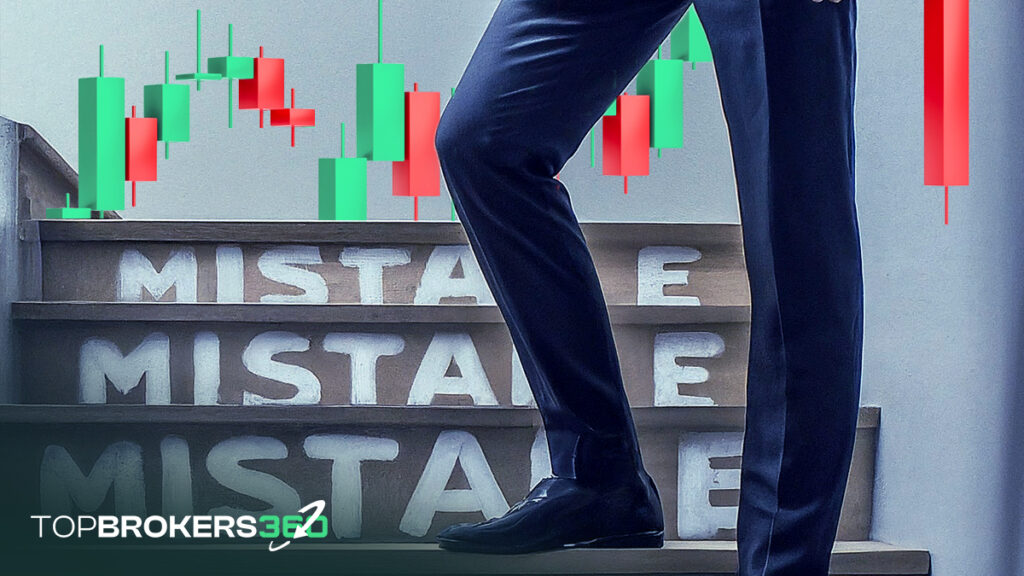Online trading is an exciting world filled with both potential profits and lurking pitfalls. This dynamic landscape demands constant vigilance, as fortunes can be made and lost in the blink of an eye. While success is attainable with the right strategies, it is also susceptible to being undermined by common mistakes made by uninformed traders.
As the legendary trader Warren Buffett wisely said, ‘The stock market is designed to transfer money from the Active to the Patient.’ This timeless wisdom emphasizes the importance of discipline and patience in trading, a lesson every trader should heed.
In this article, we will discuss three common trading mistakes that could be negatively impacting your trading goals.
Trading Mistake #1: Trading Without a Plan
Are you tired of spinning your wheels in the markets without seeing any real progress? It’s time to stop trading aimlessly and start strategizing like a pro! Don’t make the rookie mistake of neglecting to create a solid trading plan before getting started. Craft a plan that includes your risk tolerance and desired direction of movement before logging into your trading account. This way, you will have a clear-cut idea of what you’re doing in the markets and avoid getting sidetracked.
Your trading plan should encompass several key elements:
Risk Tolerance: Determine how much risk you are willing to take on each trade. This involves setting a maximum loss threshold or using tools like stop-loss orders to limit potential losses.
Trading Goals: Define your trading objectives. Are you aiming for short-term gains, long-term investments, or a combination of both? Having clear goals will guide your trading decisions.
Asset Selection: Specify the financial instruments you will trade, from stocks to forex to commodities or cryptocurrencies. Each asset class has its unique characteristics and risks.
Entry and Exit Strategies: Outline the criteria for entering a trade (buying) and exiting a trade (selling or taking profits). Having predetermined entry and exit points helps you avoid impulsive decisions driven by emotions.
Position Sizing: Decide the size of each position relative to your account size. Proper position sizing ensures you don’t risk too much capital on a single trade.
Trading Schedule: Set specific trading hours and frequency. Are you a day trader, swing trader, or long-term investor? Your trading style will influence your schedule.

By creating a detailed trading plan that incorporates these elements, you will have a clear roadmap to follow. This plan acts as your guide, ensuring you remain focused on your trading objectives and avoid the pitfalls of impulsive or emotional trading. So, before you jump into the markets, take the time to craft an extensive trading plan—it will be your first step towards trading success.
Trading Mistake #2: Letting Your Emotions Get the Best of You
Are you guilty of letting your emotions take over when making trading decisions? If you are, then it’s high time to revamp your trading style. Emotional trading can lead to significant losses and leave you feeling frustrated and defeated. Fear, greed, and anger are powerful emotions that can cloud your judgment and result in poor decision-making.
Why emotional trading is detrimental and how to overcome it:
Fear: Fear is a natural response to potential losses. When a trade moves against you, fear can lead to premature exits, causing you to miss out on potential profits. It can also paralyze you into inaction when you should be cutting your losses.
Greed: Greed can drive traders to overtrade or hold winning positions for too long in the hope of even greater gains. This often results in giving back profits or turning winning trades into losing ones.
Anger: Trading losses can be frustrating, leading to anger and a desire for revenge. Seeking vengeance on the market by taking impulsive trades to recoup losses almost always leads to more significant losses.
To avoid the emotional pitfalls of trading, consider these strategies:
Develop Discipline: Discipline is the cornerstone of successful trading. Stick to your trading plan, which should include predefined entry and exit points. By following your plan, you reduce the influence of emotions.
Use Stop-Loss Orders: Implement stop-loss orders to limit potential losses. This allows you to exit a trade automatically if it moves against you, preventing emotions from taking over.
Practice Risk Management: Determine the amount of capital you are willing to risk on each trade as part of your trading plan. This not only protects your account but also reduces the emotional impact of losses.
Stay Informed and Educated: The more you know about the financial markets and your chosen assets, the more confident you will become. Confidence reduces the impact of fear and uncertainty.
Keep Emotions in Check: Regularly assess your emotional state before and during trading. If you notice strong emotions, consider taking a break from trading until you regain composure.
Journal Your Trades: Maintain a trading journal where you record the rationale behind each trade, entry and exit points, and emotional reactions. This helps you identify patterns and areas for improvement.
By recognizing the emotional challenges of trading and actively working to mitigate them, you are able to make more rational and objective decisions. Emotionally disciplined traders are better equipped to navigate the markets successfully and avoid costly mistakes.
Trading Mistake #3: Sticking to the Same Trading Strategies
In the world of trading, global economic events can suddenly change the markets, making it challenging to rely on just one trading plan or strategy. To stay ahead of the game, you need to continuously practice, improve your skills, and expand your knowledge.
Why adaptability and continuous learning are essential:
Market Evolution: Financial markets are in a constant state of evolution. New technologies, regulatory changes, and global economic shifts can transform market dynamics. What worked as a winning strategy yesterday may not be as effective today.
Diverse Market Conditions: Different market conditions require different strategies. A trend-following strategy may excel in a trending market, while a range-bound market may favor a mean-reversion approach. Adhering to a single strategy limits your ability to capitalize on diverse market opportunities.
Risk Management: Relying solely on one strategy can expose you to significant risks. If that strategy becomes less effective or enters a drawdown period, your trading account may suffer. Diversifying your approach and incorporating multiple strategies can help spread risk and improve overall performance.
Continuous Learning: Successful traders understand the value of ongoing education. Markets are always evolving, and new trading techniques and tools emerge. By continuously expanding your knowledge and refining your skills, you stay competitive and adaptable.
How to avoid the trap of sticking to the same strategies:
Embrace Versatility: Be open to learning and incorporating various trading strategies into your repertoire. This includes day trading, swing trading, trend following, and countertrend strategies, among others.
Stay Informed: Keep abreast of financial news, economic events, and global developments that can impact the markets you trade. Awareness of market drivers is vital for adapting to changing conditions.
Backtest and Experiment: Test different strategies in various market conditions through backtesting and simulation. This allows you to evaluate their effectiveness without risking real capital.
Develop a Trading Plan: Each strategy you use should have a clearly defined trading plan, including entry and exit criteria, risk management rules, and position sizing guidelines.
Monitor and Adjust: Regularly review your trading performance and assess the effectiveness of your strategies. If a strategy is consistently underperforming or no longer aligns with market conditions, consider adjustments or replacements.
Seek Mentorship: Learning from experienced traders or seeking mentorship can accelerate your growth as a trader. Insights and guidance from those with a proven track record can be invaluable.
Maintain a Growth Mindset: Approach trading with a growth mindset that values learning from both successes and failures. Every trade is an opportunity to learn and improve.
Remember that adaptability and continuous learning are integral to long-term trading success. By diversifying your strategies and staying receptive to change, you position yourself to thrive in the financial markets. Trading is not a static endeavor, and your ability to adapt can make all the difference in your trading journey.
So, are you ready to conquer the online trading world and turn a profit? It takes more than just a stroke of luck. Success requires patience, perseverance, and a sound strategy. Avoid common pitfalls like trading without a plan, giving in to your emotions, and sticking to the same old tactics. Remember, setbacks are a part of the game, but with practice and adaptability, you too can thrive in this competitive industry. Join the ranks of millions of successful traders and take the first step towards making online trading your daily profession.
